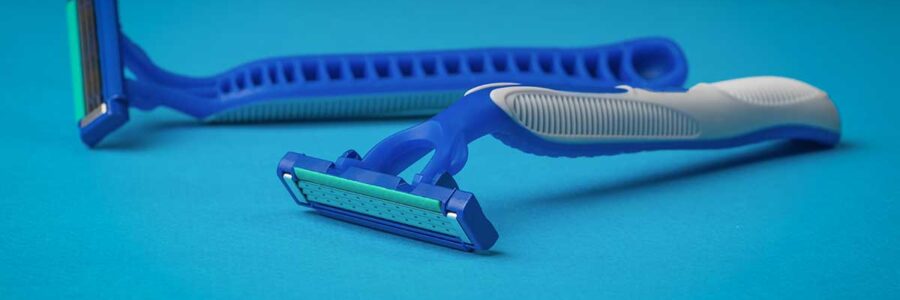For many, shaving is an essential part of personal grooming, often done without much thought about the tools we use. However, the lubricating strips on many disposable razors, designed to protect the skin, may harbor harmful chemicals like Butylated Hydroxytoluene (BHT) and Polyethylene Glycols (PEGs) that major brands use. This article explores the potential dangers that Lubricating Strips in Razors might pose, not only on the surface of our skin but also in terms of their possible absorption into our bloodstream.
The Role of the Lubricating Strip
The lubricating strip is a key feature of most disposable razors today, positioned at the top of the blade to reduce friction and provide a smoother shave. These strips often contain ingredients like polyethylene glycol (PEG), aloe vera, and vitamin E, chosen to moisturize and protect the skin. Despite their intended benefits, concerns about the safety of certain chemicals used in these strips have been raised.
Concerns About Chemical Ingredients
The focus on potentially harmful chemicals in lubricating strips has particularly been on Butylated Hydroxytoluene (BHT) and Polyethylene Glycols (PEGs.[1-4] BHT, a synthetic antioxidant found in various cosmetic and food products, is worrying due to its potential as a hormonal disruptor. Such disruptors can interfere with the body’s endocrine system, potentially leading to reproductive issues and an increased risk of cancer.[1-4]
PEGs, used for their moisturizing effects, raise alarms due to possible contamination with ethylene oxide and 1,4-dioxane during manufacturing, both of which have links to cancer and nervous system damage.[5-7] Including these chemicals in products that come into direct contact with the skin, such as razors, prompts concerns about their safety.
Scrutiny of Popular Brands
Major brands like Gillette and BIC, which dominate the personal grooming market, have come under scrutiny for the use of chemicals like BHT and PEGs in their razor strips. Despite adhering to regulatory standards, the long-term effects of these chemicals remain a topic of concern, given their widespread use. This has led to calls for greater transparency and research into safer alternatives.
Health Implications
The skin’s role as a major entry point for chemicals means substances like BHT and PEGs from lubricating strips can potentially be absorbed into the bloodstream. The risk is compounded by the regular use of razors, leading to prolonged exposure. The potential for hormonal disruption and increased cancer risk due to these chemicals highlights the need for caution and informed choice in personal care products.
Exploring Safer Alternatives
In response to these concerns, there’s a growing interest in safer shaving practices. Safety razors lack lubricating strips and provide a viable alternative with minimal chemical exposure. Some brands now offer razors with natural lubricating ingredients, such as aloe vera and shea butter, avoiding harmful chemicals. Complementing shaving with natural creams or gels and following up with gentle, alcohol-free skin care can further protect the skin.
Conclusion
The presence of potentially harmful chemicals in razor lubricating strips reminds us of the importance of vigilance in our grooming routines. While these strips aim to enhance the shaving experience, they may carry risks that could affect our health in the long run. Consumers can better safeguard their skin and overall well-being by making informed choices and seeking safer alternatives. This issue also underscores the need for more transparency and safer product development in the personal care industry, a change that will hopefully be driven by increased consumer awareness.
References:
- “Butylated Hydroxytoluene.” Butylated Hydroxytoluene – an Overview | ScienceDirect Topics, www.sciencedirect.com/topics/immunology-and-microbiology/butylated-hydroxytoluene. Accessed 31 Jan. 2024.
- Baur, A.K. et al., “The lung tumor promoter, butylated hydroxytoluene (BHT), causes chronic inflammation in promotion-sensitive BALB/cByJ mice but not in promotion-resistant CXB4 mice,” Toxicology 169, no. 1 (December 2001): 1-15.
- Wada, H. et al., “In vitro estrogenicity of resin composites,” Journal of Dental Research 83, no. 3 (March 2004): 222-6.
- Schrader, TJ and GM Cooke, “Examination of selected food additives and organochlorine food contaminants for androgenic activity in vitro,” Toxicological Sciences 53, no. 2 (February 2000): 278-88.
- Black RE, Hurley FJ, and Havery DC. “Occurrence of 1,4-dioxane in cosmetic raw materials and finished cosmetic products.” Int J PharJ AOAC Int. 84, 3 (May-Jun 2001):666-70.
- Brashear, A. et al. “Ethylene oxide neurotoxicity: a cluster of 12 nurses with peripheral and central nervous system toxicity.” Neurology 46, 4 (Apr 1996):992-8.
- California. EPA. Office of Environmental Health Hazard Assessment. Chemicals Known to the State to Cause Cancer or Reproductive Toxicity. February 5, 2010.https://www.oehha.org/prop65/prop65_list/files/P65single020510.pdf


